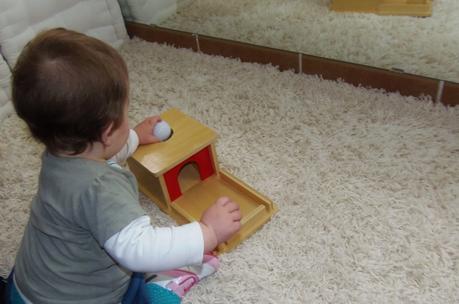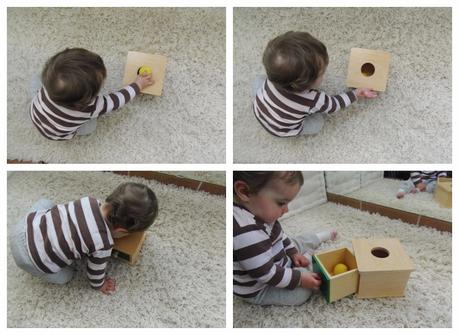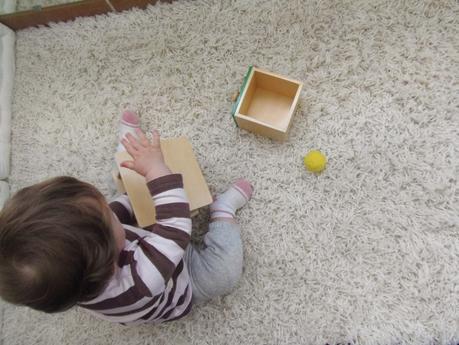(scroll down for English)
Alrededor de los 9 meses suele ser un buen momento para introducir las cajas de permanencia, aunque puede haber bebés que estén listos para este material incluso un poco antes de esta edad mientras que otros no le prestarán atención hasta más adelante.
Las cajas de permanencia permiten al bebé a entender que cuando un objeto desaparece de nuestra vista no deja de existir, algo que les ayuda a superar la famosa ansiedad de la separación. Además sirven para trabajar la coordinación ojo-mano y la motricidad fina.
Caja de permanencia con bandeja
El primer contacto de Sara con la primera de estas cajas, la caja de permanencia con bandeja, fue poco después de cumplir los 9 meses y me hizo darme cuenta de que se la tenía que haber presentado antes, porque en cuanto se la presenté cogió la bola, la metió sin ningún problema por el agujero, y se fue gateando a hacer otra cosa. Un claro ejemplo de un material que no “engancha” al niño porque le resulta demasiado fácil, y un gran momento de aprendizaje, no para ella, sino para mí, que descubrí que su coordinación ojo-mano es mucho más avanzada de lo que yo pensaba!

Cajas de permanencia con cajón
Viendo que la caja de permanencia con bandeja estaba dominada, al día siguiente le presenté la primera caja de permanencia con cajón, y esta vez si que le atrajo algo más el material. Como al meter la bola por el agujero ésta no aparece a menos que abramos el cajón, le hacía mucha gracia mirar por el agujero para averiguar dónde había ido la bola antes de abrir el cajón para sacarla.

El único problema que tiene este material para ella por el momento es que una vez que saca el cajón no es capaz de volver a meterlo, por lo que es imposible que pueda darse la repetición del ejercicio. Normalmente una vez que saca el cajón se pone a examinarlo desde todos los ángulos posibles, lo golpea con la mano para ver cómo suena, pone la bola dentro y luego la saca… Imagino que con el tiempo conseguirá volver a meterlo en la caja, así que por el momento este material lo tenemos a su alcance para que pueda trabajar con él cuando quiera.

Más adelante le presentaré la caja de permanencia con cajón y monedas, que necesita una coordinación ojo-mano más avanzada para introducir las monedas por la ranura.
Si quieres aprender más sobre los materiales y las actividades Montessori para la etapa de 0 a 3 años tal vez te interese mi curso online “Integra Montessori en la Crianza de tus Hijos (II): Montessori de 0 a 3 años”
Te ha gustado?
Compártelo!
O déjame un comentario!
O haz las dos cosas!
——————–
Around 9 months is usually a good time to introduce the object permanence boxes, although there may be babies who are ready for this material even a little before this age while others will not pay attention to it until later.
Permanence boxes allow the baby to understand that when an object disappears from our view it doesn’t mean it no longer exists, this is something that helps them overcome the famous separation anxiety. These materials also work hand-eye coordination and fine motor skills.
Permanence box with tray
The first contact Sara had with the first of these boxes, the permanence box with tray, was shortly after she turned 9 months and it made me realize that I should have introduced it earlier because as soon as I presented it she grabbed the ball, fit it easily through the hole, and went away crawling. A clear example of a material that doesn’t “engage” the child because it is too easy, and a great time of learning, not for her but for me, as I discovered that her hand-eye coordination is much more advanced than I thought!
Permanence boxes with drawer
Seeing that the permanence box with tray was mastered, the next day I presented the first permanence box with drawer, and this time she was more attracted by the material. As when the ball falls into the hole it does not appear unless we open the drawer, she found it very funny to look through the hole to see the ball before opening the drawer to get it.
The only problem with this material for her at the moment is that once she opens the drawer she is not able to put it back, so she can’t repeat the exercise if she wants. Usually once she opens the drawer she grabs it to examine it from all possible angles, hits it with her hand to see how it sounds, puts the ball in and then takes it out… I imagine that eventually she will get to put it back in the box so for now we have this material at her reach so she can work with it anytime.
Later I will present the permanence box with drawer and coins, which needs a more advanced hand-eye coordination to feed coins into the slot.

